Design Thinking Experience
VerifiedAdded on 2023/04/03
|11
|2431
|216
AI Summary
This document discusses the design thinking experience of a student in a collaborative process for a creative designing activity. It explores the journey map phase and other associated processes in the group-work. The student reflects on the experience and discusses the scope of improvement for future projects.
Contribute Materials
Your contribution can guide someone’s learning journey. Share your
documents today.
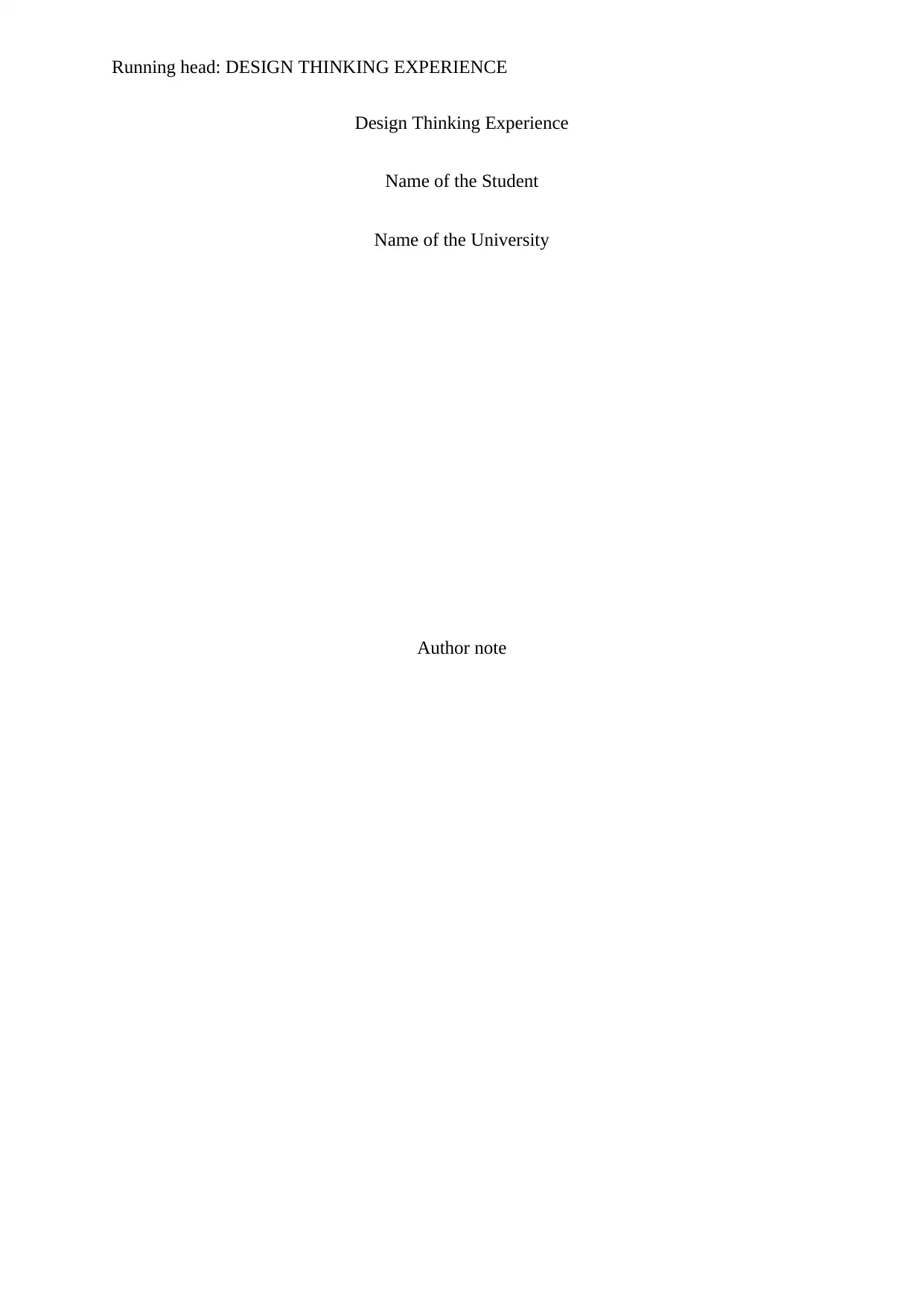
Running head: DESIGN THINKING EXPERIENCE
Design Thinking Experience
Name of the Student
Name of the University
Author note
Design Thinking Experience
Name of the Student
Name of the University
Author note
Secure Best Marks with AI Grader
Need help grading? Try our AI Grader for instant feedback on your assignments.
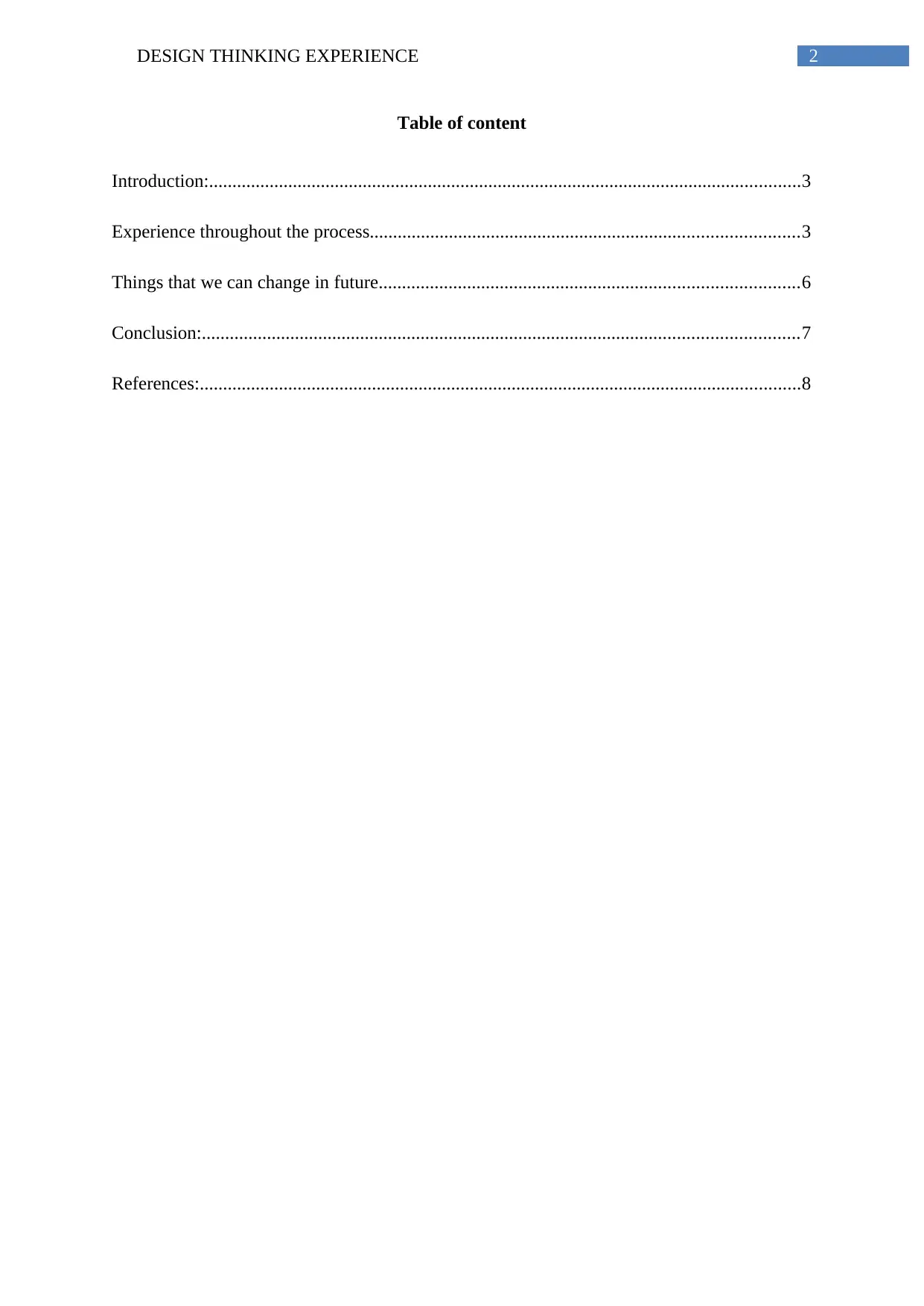
2DESIGN THINKING EXPERIENCE
Table of content
Introduction:...............................................................................................................................3
Experience throughout the process............................................................................................3
Things that we can change in future..........................................................................................6
Conclusion:................................................................................................................................7
References:.................................................................................................................................8
Table of content
Introduction:...............................................................................................................................3
Experience throughout the process............................................................................................3
Things that we can change in future..........................................................................................6
Conclusion:................................................................................................................................7
References:.................................................................................................................................8
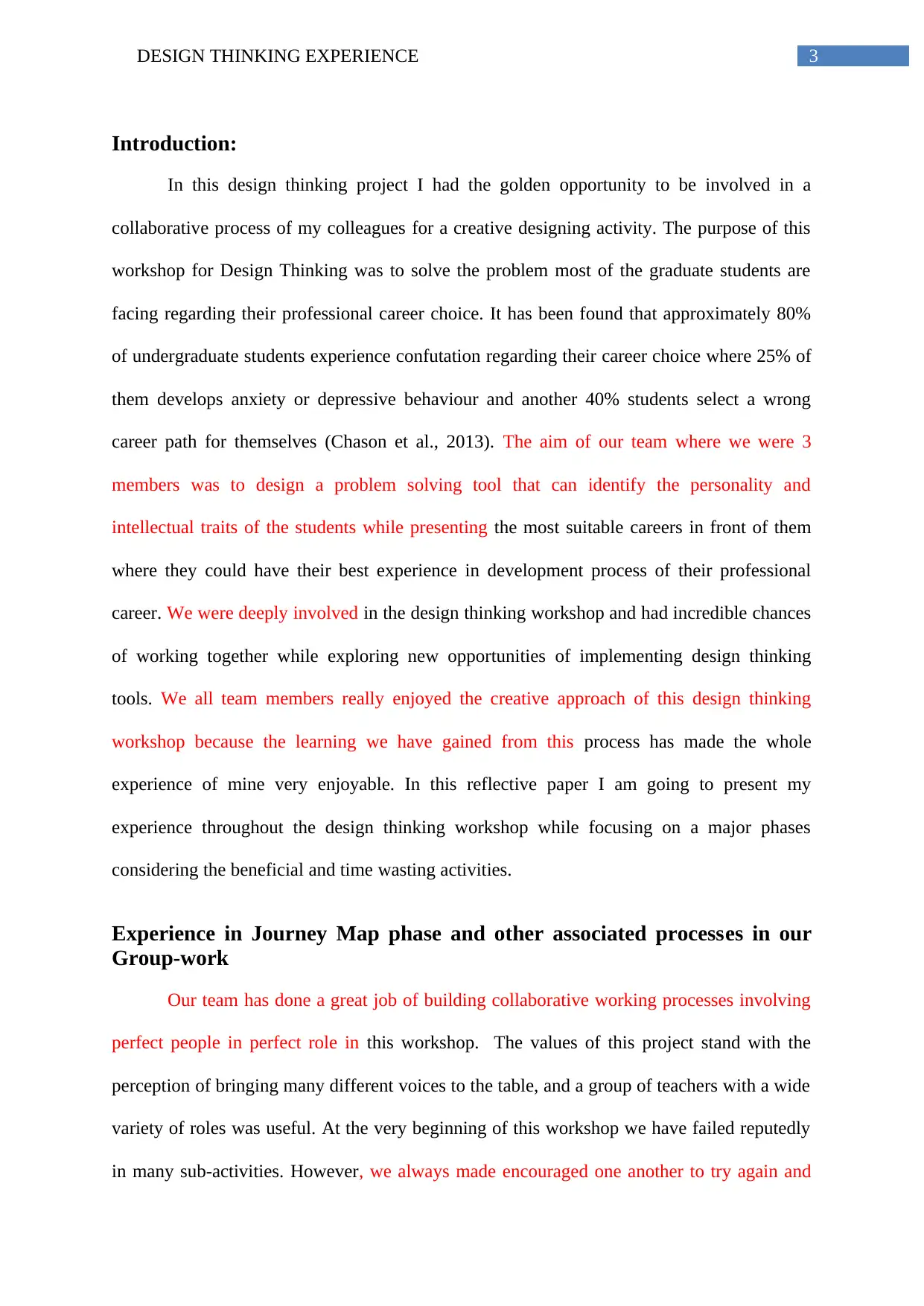
3DESIGN THINKING EXPERIENCE
Introduction:
In this design thinking project I had the golden opportunity to be involved in a
collaborative process of my colleagues for a creative designing activity. The purpose of this
workshop for Design Thinking was to solve the problem most of the graduate students are
facing regarding their professional career choice. It has been found that approximately 80%
of undergraduate students experience confutation regarding their career choice where 25% of
them develops anxiety or depressive behaviour and another 40% students select a wrong
career path for themselves (Chason et al., 2013). The aim of our team where we were 3
members was to design a problem solving tool that can identify the personality and
intellectual traits of the students while presenting the most suitable careers in front of them
where they could have their best experience in development process of their professional
career. We were deeply involved in the design thinking workshop and had incredible chances
of working together while exploring new opportunities of implementing design thinking
tools. We all team members really enjoyed the creative approach of this design thinking
workshop because the learning we have gained from this process has made the whole
experience of mine very enjoyable. In this reflective paper I am going to present my
experience throughout the design thinking workshop while focusing on a major phases
considering the beneficial and time wasting activities.
Experience in Journey Map phase and other associated processes in our
Group-work
Our team has done a great job of building collaborative working processes involving
perfect people in perfect role in this workshop. The values of this project stand with the
perception of bringing many different voices to the table, and a group of teachers with a wide
variety of roles was useful. At the very beginning of this workshop we have failed reputedly
in many sub-activities. However, we always made encouraged one another to try again and
Introduction:
In this design thinking project I had the golden opportunity to be involved in a
collaborative process of my colleagues for a creative designing activity. The purpose of this
workshop for Design Thinking was to solve the problem most of the graduate students are
facing regarding their professional career choice. It has been found that approximately 80%
of undergraduate students experience confutation regarding their career choice where 25% of
them develops anxiety or depressive behaviour and another 40% students select a wrong
career path for themselves (Chason et al., 2013). The aim of our team where we were 3
members was to design a problem solving tool that can identify the personality and
intellectual traits of the students while presenting the most suitable careers in front of them
where they could have their best experience in development process of their professional
career. We were deeply involved in the design thinking workshop and had incredible chances
of working together while exploring new opportunities of implementing design thinking
tools. We all team members really enjoyed the creative approach of this design thinking
workshop because the learning we have gained from this process has made the whole
experience of mine very enjoyable. In this reflective paper I am going to present my
experience throughout the design thinking workshop while focusing on a major phases
considering the beneficial and time wasting activities.
Experience in Journey Map phase and other associated processes in our
Group-work
Our team has done a great job of building collaborative working processes involving
perfect people in perfect role in this workshop. The values of this project stand with the
perception of bringing many different voices to the table, and a group of teachers with a wide
variety of roles was useful. At the very beginning of this workshop we have failed reputedly
in many sub-activities. However, we always made encouraged one another to try again and
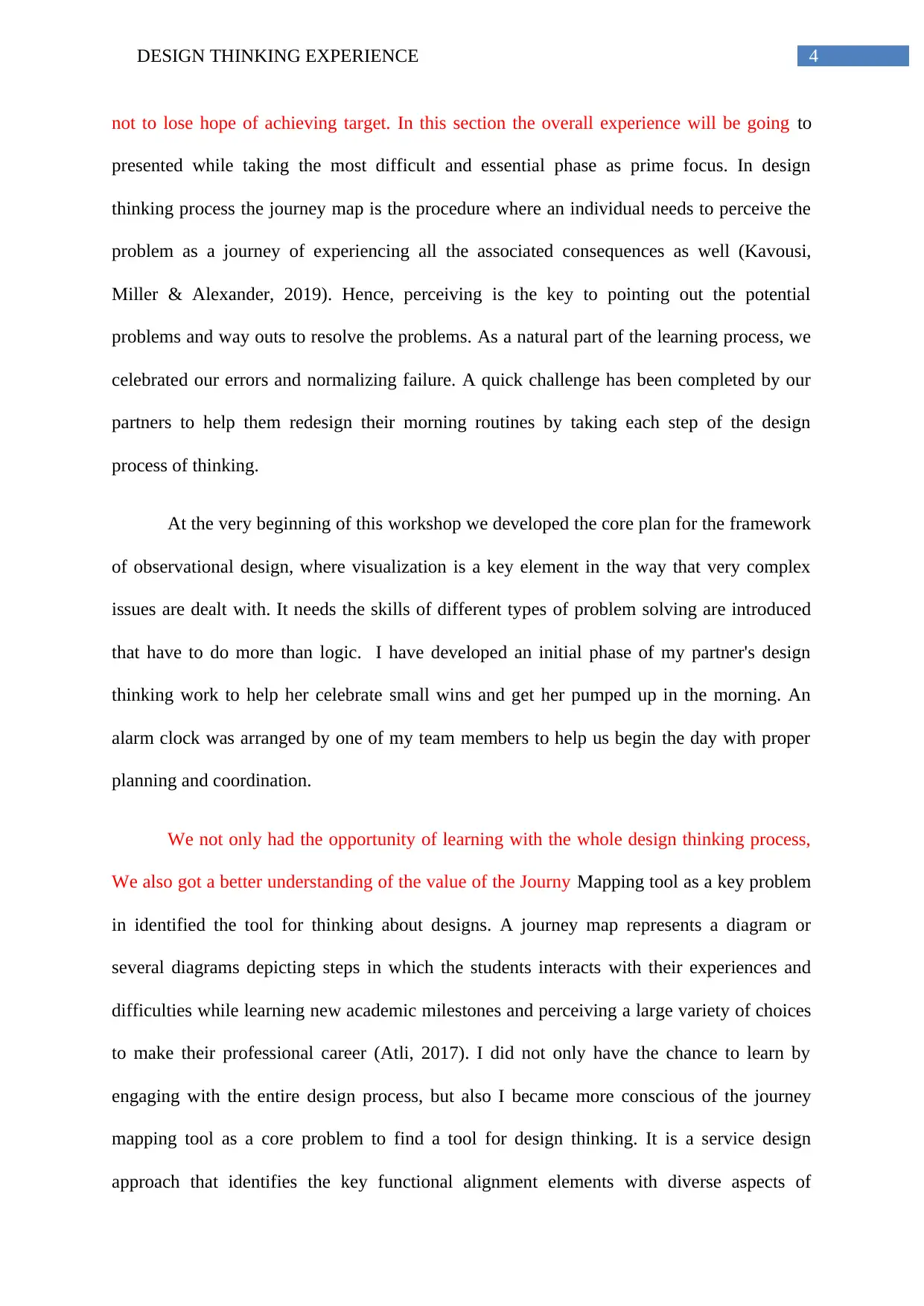
4DESIGN THINKING EXPERIENCE
not to lose hope of achieving target. In this section the overall experience will be going to
presented while taking the most difficult and essential phase as prime focus. In design
thinking process the journey map is the procedure where an individual needs to perceive the
problem as a journey of experiencing all the associated consequences as well (Kavousi,
Miller & Alexander, 2019). Hence, perceiving is the key to pointing out the potential
problems and way outs to resolve the problems. As a natural part of the learning process, we
celebrated our errors and normalizing failure. A quick challenge has been completed by our
partners to help them redesign their morning routines by taking each step of the design
process of thinking.
At the very beginning of this workshop we developed the core plan for the framework
of observational design, where visualization is a key element in the way that very complex
issues are dealt with. It needs the skills of different types of problem solving are introduced
that have to do more than logic. I have developed an initial phase of my partner's design
thinking work to help her celebrate small wins and get her pumped up in the morning. An
alarm clock was arranged by one of my team members to help us begin the day with proper
planning and coordination.
We not only had the opportunity of learning with the whole design thinking process,
We also got a better understanding of the value of the Journy Mapping tool as a key problem
in identified the tool for thinking about designs. A journey map represents a diagram or
several diagrams depicting steps in which the students interacts with their experiences and
difficulties while learning new academic milestones and perceiving a large variety of choices
to make their professional career (Atli, 2017). I did not only have the chance to learn by
engaging with the entire design process, but also I became more conscious of the journey
mapping tool as a core problem to find a tool for design thinking. It is a service design
approach that identifies the key functional alignment elements with diverse aspects of
not to lose hope of achieving target. In this section the overall experience will be going to
presented while taking the most difficult and essential phase as prime focus. In design
thinking process the journey map is the procedure where an individual needs to perceive the
problem as a journey of experiencing all the associated consequences as well (Kavousi,
Miller & Alexander, 2019). Hence, perceiving is the key to pointing out the potential
problems and way outs to resolve the problems. As a natural part of the learning process, we
celebrated our errors and normalizing failure. A quick challenge has been completed by our
partners to help them redesign their morning routines by taking each step of the design
process of thinking.
At the very beginning of this workshop we developed the core plan for the framework
of observational design, where visualization is a key element in the way that very complex
issues are dealt with. It needs the skills of different types of problem solving are introduced
that have to do more than logic. I have developed an initial phase of my partner's design
thinking work to help her celebrate small wins and get her pumped up in the morning. An
alarm clock was arranged by one of my team members to help us begin the day with proper
planning and coordination.
We not only had the opportunity of learning with the whole design thinking process,
We also got a better understanding of the value of the Journy Mapping tool as a key problem
in identified the tool for thinking about designs. A journey map represents a diagram or
several diagrams depicting steps in which the students interacts with their experiences and
difficulties while learning new academic milestones and perceiving a large variety of choices
to make their professional career (Atli, 2017). I did not only have the chance to learn by
engaging with the entire design process, but also I became more conscious of the journey
mapping tool as a core problem to find a tool for design thinking. It is a service design
approach that identifies the key functional alignment elements with diverse aspects of
Paraphrase This Document
Need a fresh take? Get an instant paraphrase of this document with our AI Paraphraser
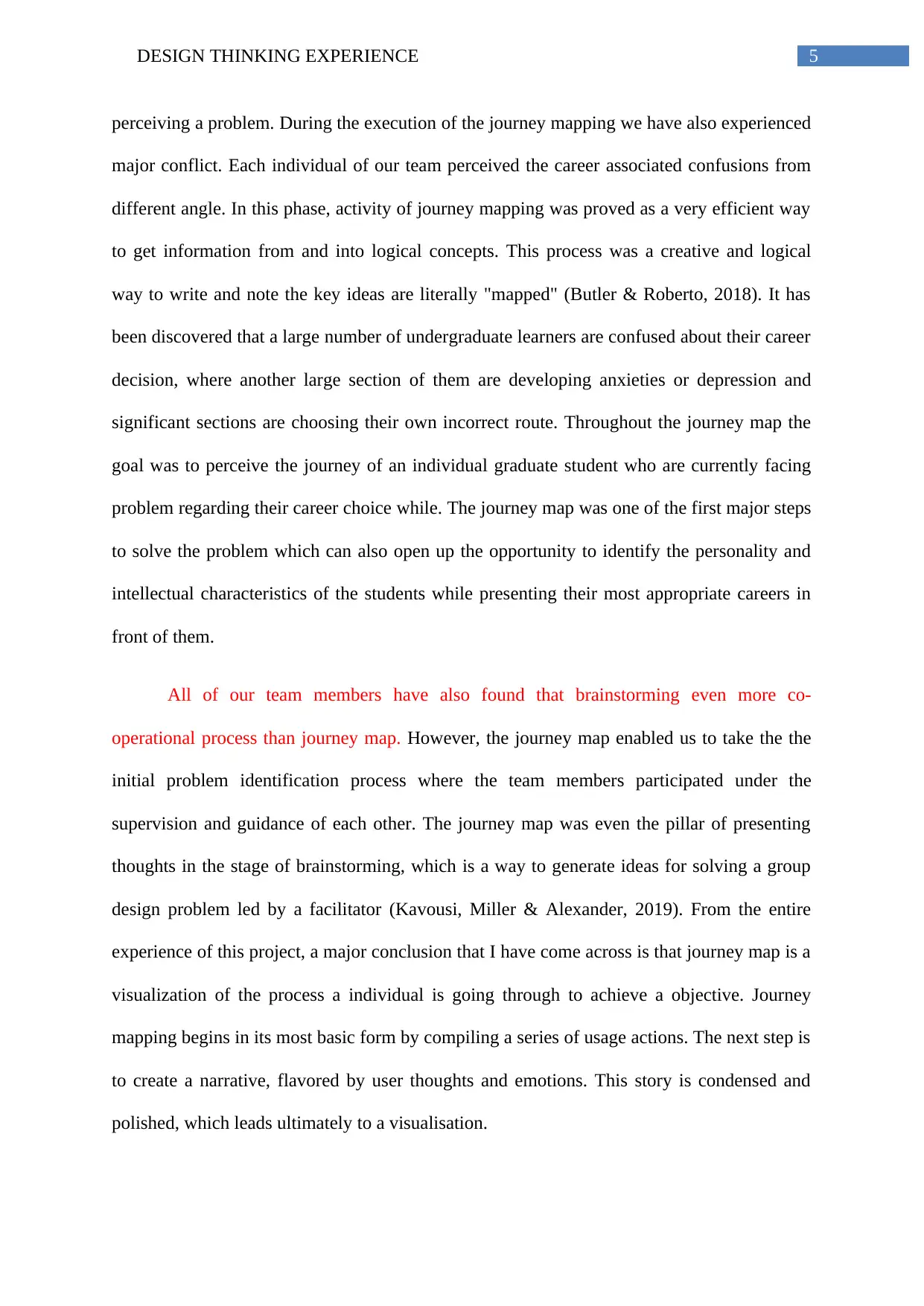
5DESIGN THINKING EXPERIENCE
perceiving a problem. During the execution of the journey mapping we have also experienced
major conflict. Each individual of our team perceived the career associated confusions from
different angle. In this phase, activity of journey mapping was proved as a very efficient way
to get information from and into logical concepts. This process was a creative and logical
way to write and note the key ideas are literally "mapped" (Butler & Roberto, 2018). It has
been discovered that a large number of undergraduate learners are confused about their career
decision, where another large section of them are developing anxieties or depression and
significant sections are choosing their own incorrect route. Throughout the journey map the
goal was to perceive the journey of an individual graduate student who are currently facing
problem regarding their career choice while. The journey map was one of the first major steps
to solve the problem which can also open up the opportunity to identify the personality and
intellectual characteristics of the students while presenting their most appropriate careers in
front of them.
All of our team members have also found that brainstorming even more co-
operational process than journey map. However, the journey map enabled us to take the the
initial problem identification process where the team members participated under the
supervision and guidance of each other. The journey map was even the pillar of presenting
thoughts in the stage of brainstorming, which is a way to generate ideas for solving a group
design problem led by a facilitator (Kavousi, Miller & Alexander, 2019). From the entire
experience of this project, a major conclusion that I have come across is that journey map is a
visualization of the process a individual is going through to achieve a objective. Journey
mapping begins in its most basic form by compiling a series of usage actions. The next step is
to create a narrative, flavored by user thoughts and emotions. This story is condensed and
polished, which leads ultimately to a visualisation.
perceiving a problem. During the execution of the journey mapping we have also experienced
major conflict. Each individual of our team perceived the career associated confusions from
different angle. In this phase, activity of journey mapping was proved as a very efficient way
to get information from and into logical concepts. This process was a creative and logical
way to write and note the key ideas are literally "mapped" (Butler & Roberto, 2018). It has
been discovered that a large number of undergraduate learners are confused about their career
decision, where another large section of them are developing anxieties or depression and
significant sections are choosing their own incorrect route. Throughout the journey map the
goal was to perceive the journey of an individual graduate student who are currently facing
problem regarding their career choice while. The journey map was one of the first major steps
to solve the problem which can also open up the opportunity to identify the personality and
intellectual characteristics of the students while presenting their most appropriate careers in
front of them.
All of our team members have also found that brainstorming even more co-
operational process than journey map. However, the journey map enabled us to take the the
initial problem identification process where the team members participated under the
supervision and guidance of each other. The journey map was even the pillar of presenting
thoughts in the stage of brainstorming, which is a way to generate ideas for solving a group
design problem led by a facilitator (Kavousi, Miller & Alexander, 2019). From the entire
experience of this project, a major conclusion that I have come across is that journey map is a
visualization of the process a individual is going through to achieve a objective. Journey
mapping begins in its most basic form by compiling a series of usage actions. The next step is
to create a narrative, flavored by user thoughts and emotions. This story is condensed and
polished, which leads ultimately to a visualisation.

6DESIGN THINKING EXPERIENCE
Following the brainstorm, we continued to develop the key solution idea, which was a
portable application to help learners manage time. Conceptual design allows fresh, innovative
and creative thoughts and tries to balance all the different variables which influence the
objective outcome (Mahmoud-Jouini, Midler & Silberzahn, 2016). After concept
development, we have developed several field-based experimental plans for examining the
outcome of the chosen plan by engaging with the assumption testing process. This process
was based on identifying the assumptions that underlie the effectiveness of a new problem
solving plan and on evaluating the likelihood of the assumptions. We decided to start
prototyping after having a list of possible results. When the rapid process of prototyping took
place, the time constraints exacerbated it. They helped me to develop several new concepts
and ideas while allowing me to how the "user" of this system can be involved in this building
process. As we were reminded by the leaders of our workshop, the aim is to "reveal a sense"
and not create an individual product (Valentim, Silva & Conte, 2017). The purpose and
procedure of the design thinking process significantly helped us to change our individual
view on the usefulness of this processes in different problem solving situations.
After creating the primary prototype, our workshop has engaged a few potential
customers who can share ideas about the product and its usefulness. Customer CoCreation
incorporates techniques that enable managers to engage the client while developing new ideas
of mutual interest (Davis, Abererty & Dowling 2016) in the process of generation and
development. After this step, we entered the final and final phase of design which was the
beginning of learning. Contrary to a complete new product deployment, a learning start is a
quick and inexpensive learning experiment to collect data from the market. For the whole
workshop, we have divided into different goals in order to meet our design challenge: help
university students with choosing proper career path. We began the task with the stage of
empathy and went to a collage campus to interview people as both students and individuals
Following the brainstorm, we continued to develop the key solution idea, which was a
portable application to help learners manage time. Conceptual design allows fresh, innovative
and creative thoughts and tries to balance all the different variables which influence the
objective outcome (Mahmoud-Jouini, Midler & Silberzahn, 2016). After concept
development, we have developed several field-based experimental plans for examining the
outcome of the chosen plan by engaging with the assumption testing process. This process
was based on identifying the assumptions that underlie the effectiveness of a new problem
solving plan and on evaluating the likelihood of the assumptions. We decided to start
prototyping after having a list of possible results. When the rapid process of prototyping took
place, the time constraints exacerbated it. They helped me to develop several new concepts
and ideas while allowing me to how the "user" of this system can be involved in this building
process. As we were reminded by the leaders of our workshop, the aim is to "reveal a sense"
and not create an individual product (Valentim, Silva & Conte, 2017). The purpose and
procedure of the design thinking process significantly helped us to change our individual
view on the usefulness of this processes in different problem solving situations.
After creating the primary prototype, our workshop has engaged a few potential
customers who can share ideas about the product and its usefulness. Customer CoCreation
incorporates techniques that enable managers to engage the client while developing new ideas
of mutual interest (Davis, Abererty & Dowling 2016) in the process of generation and
development. After this step, we entered the final and final phase of design which was the
beginning of learning. Contrary to a complete new product deployment, a learning start is a
quick and inexpensive learning experiment to collect data from the market. For the whole
workshop, we have divided into different goals in order to meet our design challenge: help
university students with choosing proper career path. We began the task with the stage of
empathy and went to a collage campus to interview people as both students and individuals
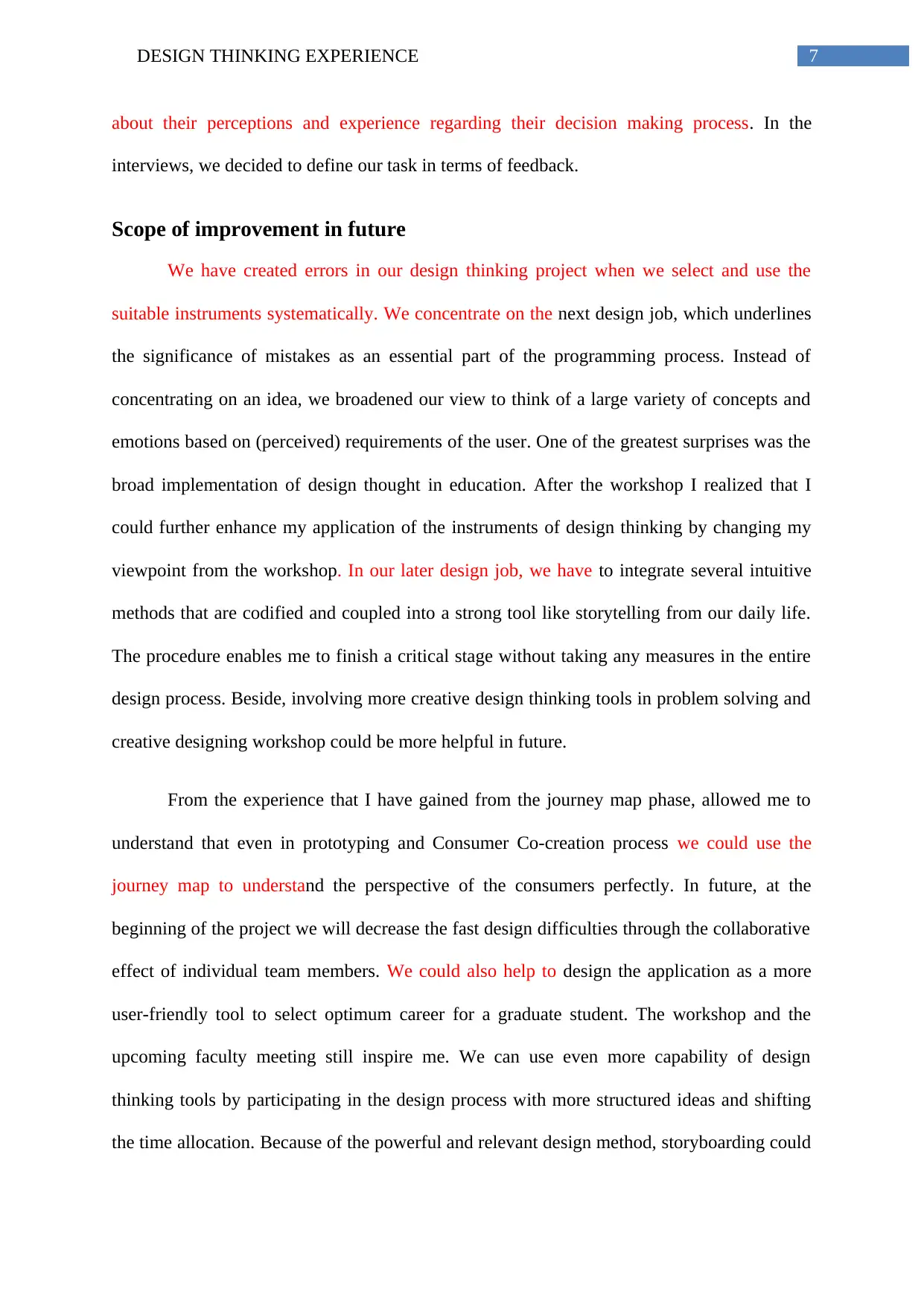
7DESIGN THINKING EXPERIENCE
about their perceptions and experience regarding their decision making process. In the
interviews, we decided to define our task in terms of feedback.
Scope of improvement in future
We have created errors in our design thinking project when we select and use the
suitable instruments systematically. We concentrate on the next design job, which underlines
the significance of mistakes as an essential part of the programming process. Instead of
concentrating on an idea, we broadened our view to think of a large variety of concepts and
emotions based on (perceived) requirements of the user. One of the greatest surprises was the
broad implementation of design thought in education. After the workshop I realized that I
could further enhance my application of the instruments of design thinking by changing my
viewpoint from the workshop. In our later design job, we have to integrate several intuitive
methods that are codified and coupled into a strong tool like storytelling from our daily life.
The procedure enables me to finish a critical stage without taking any measures in the entire
design process. Beside, involving more creative design thinking tools in problem solving and
creative designing workshop could be more helpful in future.
From the experience that I have gained from the journey map phase, allowed me to
understand that even in prototyping and Consumer Co-creation process we could use the
journey map to understand the perspective of the consumers perfectly. In future, at the
beginning of the project we will decrease the fast design difficulties through the collaborative
effect of individual team members. We could also help to design the application as a more
user-friendly tool to select optimum career for a graduate student. The workshop and the
upcoming faculty meeting still inspire me. We can use even more capability of design
thinking tools by participating in the design process with more structured ideas and shifting
the time allocation. Because of the powerful and relevant design method, storyboarding could
about their perceptions and experience regarding their decision making process. In the
interviews, we decided to define our task in terms of feedback.
Scope of improvement in future
We have created errors in our design thinking project when we select and use the
suitable instruments systematically. We concentrate on the next design job, which underlines
the significance of mistakes as an essential part of the programming process. Instead of
concentrating on an idea, we broadened our view to think of a large variety of concepts and
emotions based on (perceived) requirements of the user. One of the greatest surprises was the
broad implementation of design thought in education. After the workshop I realized that I
could further enhance my application of the instruments of design thinking by changing my
viewpoint from the workshop. In our later design job, we have to integrate several intuitive
methods that are codified and coupled into a strong tool like storytelling from our daily life.
The procedure enables me to finish a critical stage without taking any measures in the entire
design process. Beside, involving more creative design thinking tools in problem solving and
creative designing workshop could be more helpful in future.
From the experience that I have gained from the journey map phase, allowed me to
understand that even in prototyping and Consumer Co-creation process we could use the
journey map to understand the perspective of the consumers perfectly. In future, at the
beginning of the project we will decrease the fast design difficulties through the collaborative
effect of individual team members. We could also help to design the application as a more
user-friendly tool to select optimum career for a graduate student. The workshop and the
upcoming faculty meeting still inspire me. We can use even more capability of design
thinking tools by participating in the design process with more structured ideas and shifting
the time allocation. Because of the powerful and relevant design method, storyboarding could
Secure Best Marks with AI Grader
Need help grading? Try our AI Grader for instant feedback on your assignments.
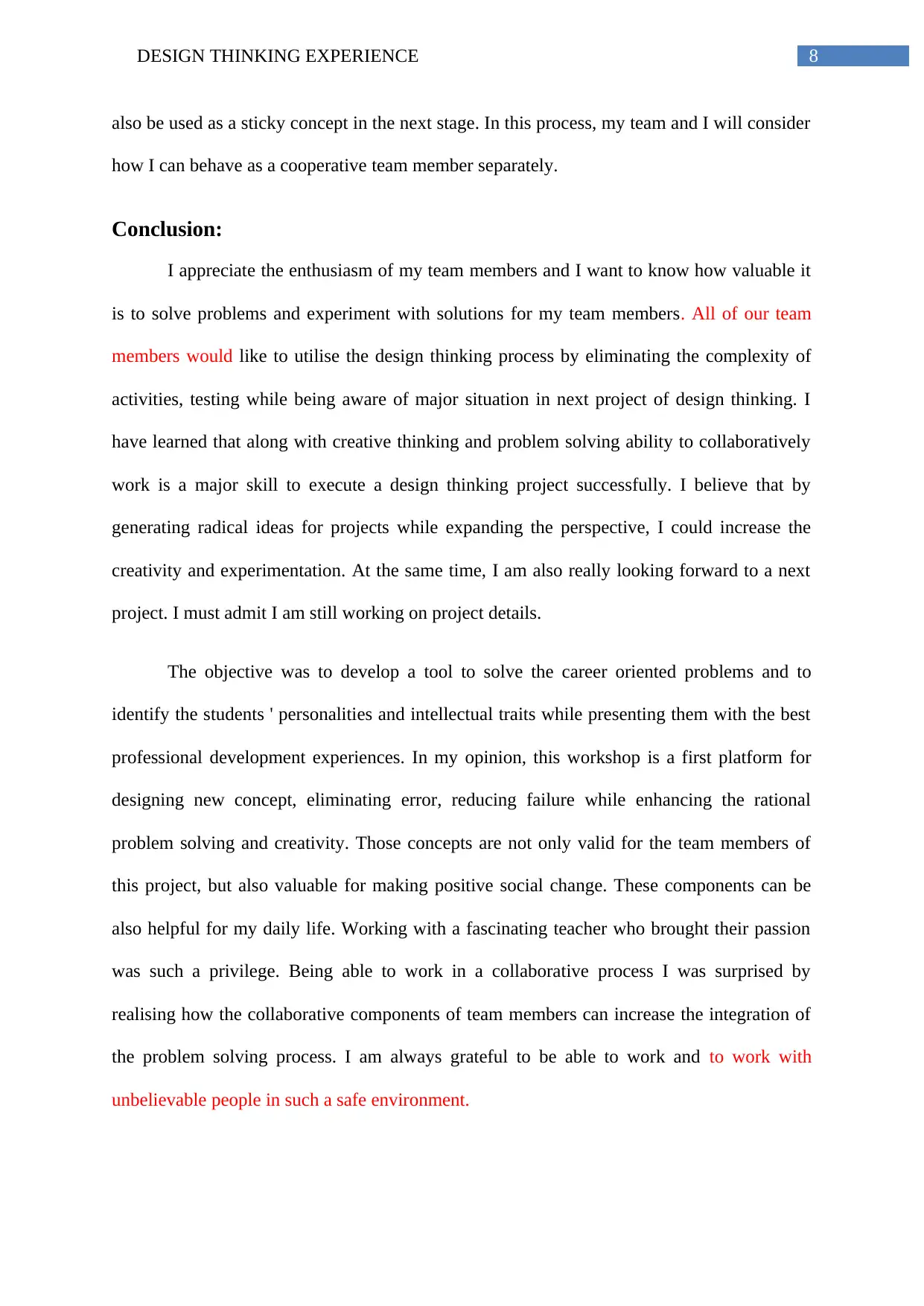
8DESIGN THINKING EXPERIENCE
also be used as a sticky concept in the next stage. In this process, my team and I will consider
how I can behave as a cooperative team member separately.
Conclusion:
I appreciate the enthusiasm of my team members and I want to know how valuable it
is to solve problems and experiment with solutions for my team members. All of our team
members would like to utilise the design thinking process by eliminating the complexity of
activities, testing while being aware of major situation in next project of design thinking. I
have learned that along with creative thinking and problem solving ability to collaboratively
work is a major skill to execute a design thinking project successfully. I believe that by
generating radical ideas for projects while expanding the perspective, I could increase the
creativity and experimentation. At the same time, I am also really looking forward to a next
project. I must admit I am still working on project details.
The objective was to develop a tool to solve the career oriented problems and to
identify the students ' personalities and intellectual traits while presenting them with the best
professional development experiences. In my opinion, this workshop is a first platform for
designing new concept, eliminating error, reducing failure while enhancing the rational
problem solving and creativity. Those concepts are not only valid for the team members of
this project, but also valuable for making positive social change. These components can be
also helpful for my daily life. Working with a fascinating teacher who brought their passion
was such a privilege. Being able to work in a collaborative process I was surprised by
realising how the collaborative components of team members can increase the integration of
the problem solving process. I am always grateful to be able to work and to work with
unbelievable people in such a safe environment.
also be used as a sticky concept in the next stage. In this process, my team and I will consider
how I can behave as a cooperative team member separately.
Conclusion:
I appreciate the enthusiasm of my team members and I want to know how valuable it
is to solve problems and experiment with solutions for my team members. All of our team
members would like to utilise the design thinking process by eliminating the complexity of
activities, testing while being aware of major situation in next project of design thinking. I
have learned that along with creative thinking and problem solving ability to collaboratively
work is a major skill to execute a design thinking project successfully. I believe that by
generating radical ideas for projects while expanding the perspective, I could increase the
creativity and experimentation. At the same time, I am also really looking forward to a next
project. I must admit I am still working on project details.
The objective was to develop a tool to solve the career oriented problems and to
identify the students ' personalities and intellectual traits while presenting them with the best
professional development experiences. In my opinion, this workshop is a first platform for
designing new concept, eliminating error, reducing failure while enhancing the rational
problem solving and creativity. Those concepts are not only valid for the team members of
this project, but also valuable for making positive social change. These components can be
also helpful for my daily life. Working with a fascinating teacher who brought their passion
was such a privilege. Being able to work in a collaborative process I was surprised by
realising how the collaborative components of team members can increase the integration of
the problem solving process. I am always grateful to be able to work and to work with
unbelievable people in such a safe environment.

9DESIGN THINKING EXPERIENCE
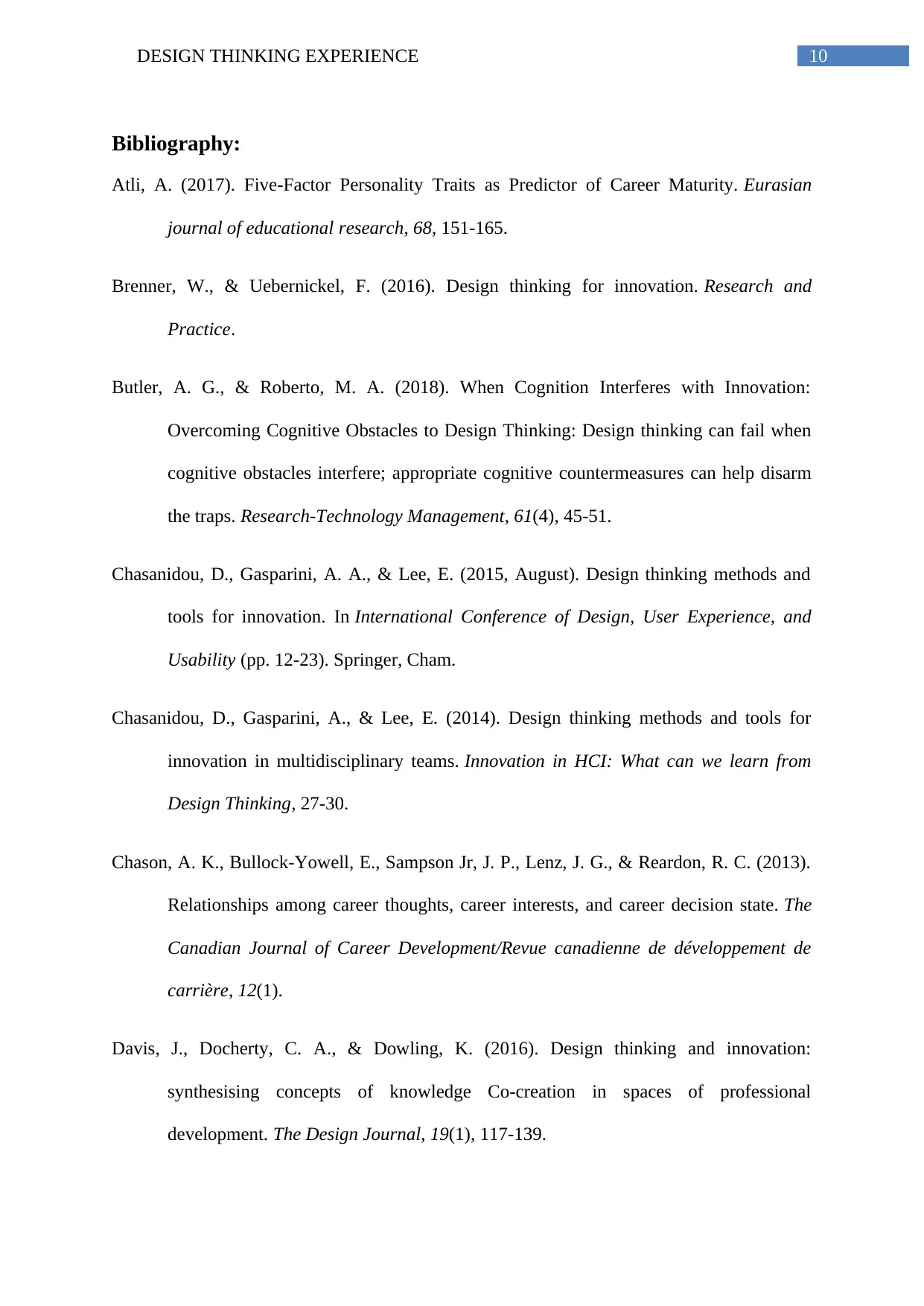
10DESIGN THINKING EXPERIENCE
Bibliography:
Atli, A. (2017). Five-Factor Personality Traits as Predictor of Career Maturity. Eurasian
journal of educational research, 68, 151-165.
Brenner, W., & Uebernickel, F. (2016). Design thinking for innovation. Research and
Practice.
Butler, A. G., & Roberto, M. A. (2018). When Cognition Interferes with Innovation:
Overcoming Cognitive Obstacles to Design Thinking: Design thinking can fail when
cognitive obstacles interfere; appropriate cognitive countermeasures can help disarm
the traps. Research-Technology Management, 61(4), 45-51.
Chasanidou, D., Gasparini, A. A., & Lee, E. (2015, August). Design thinking methods and
tools for innovation. In International Conference of Design, User Experience, and
Usability (pp. 12-23). Springer, Cham.
Chasanidou, D., Gasparini, A., & Lee, E. (2014). Design thinking methods and tools for
innovation in multidisciplinary teams. Innovation in HCI: What can we learn from
Design Thinking, 27-30.
Chason, A. K., Bullock-Yowell, E., Sampson Jr, J. P., Lenz, J. G., & Reardon, R. C. (2013).
Relationships among career thoughts, career interests, and career decision state. The
Canadian Journal of Career Development/Revue canadienne de développement de
carrière, 12(1).
Davis, J., Docherty, C. A., & Dowling, K. (2016). Design thinking and innovation:
synthesising concepts of knowledge Co-creation in spaces of professional
development. The Design Journal, 19(1), 117-139.
Bibliography:
Atli, A. (2017). Five-Factor Personality Traits as Predictor of Career Maturity. Eurasian
journal of educational research, 68, 151-165.
Brenner, W., & Uebernickel, F. (2016). Design thinking for innovation. Research and
Practice.
Butler, A. G., & Roberto, M. A. (2018). When Cognition Interferes with Innovation:
Overcoming Cognitive Obstacles to Design Thinking: Design thinking can fail when
cognitive obstacles interfere; appropriate cognitive countermeasures can help disarm
the traps. Research-Technology Management, 61(4), 45-51.
Chasanidou, D., Gasparini, A. A., & Lee, E. (2015, August). Design thinking methods and
tools for innovation. In International Conference of Design, User Experience, and
Usability (pp. 12-23). Springer, Cham.
Chasanidou, D., Gasparini, A., & Lee, E. (2014). Design thinking methods and tools for
innovation in multidisciplinary teams. Innovation in HCI: What can we learn from
Design Thinking, 27-30.
Chason, A. K., Bullock-Yowell, E., Sampson Jr, J. P., Lenz, J. G., & Reardon, R. C. (2013).
Relationships among career thoughts, career interests, and career decision state. The
Canadian Journal of Career Development/Revue canadienne de développement de
carrière, 12(1).
Davis, J., Docherty, C. A., & Dowling, K. (2016). Design thinking and innovation:
synthesising concepts of knowledge Co-creation in spaces of professional
development. The Design Journal, 19(1), 117-139.
Paraphrase This Document
Need a fresh take? Get an instant paraphrase of this document with our AI Paraphraser
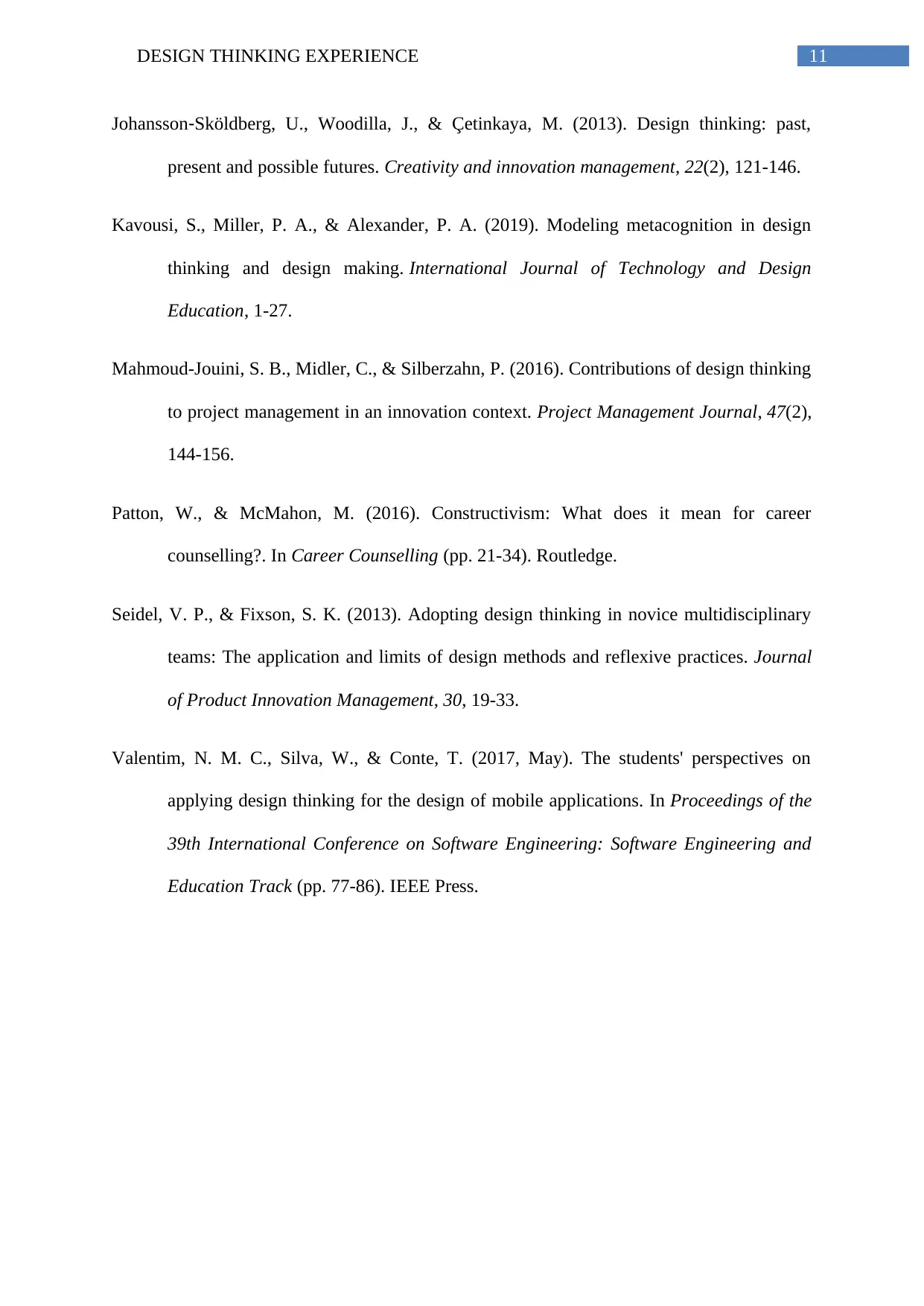
11DESIGN THINKING EXPERIENCE
Johansson‐Sköldberg, U., Woodilla, J., & Çetinkaya, M. (2013). Design thinking: past,
present and possible futures. Creativity and innovation management, 22(2), 121-146.
Kavousi, S., Miller, P. A., & Alexander, P. A. (2019). Modeling metacognition in design
thinking and design making. International Journal of Technology and Design
Education, 1-27.
Mahmoud-Jouini, S. B., Midler, C., & Silberzahn, P. (2016). Contributions of design thinking
to project management in an innovation context. Project Management Journal, 47(2),
144-156.
Patton, W., & McMahon, M. (2016). Constructivism: What does it mean for career
counselling?. In Career Counselling (pp. 21-34). Routledge.
Seidel, V. P., & Fixson, S. K. (2013). Adopting design thinking in novice multidisciplinary
teams: The application and limits of design methods and reflexive practices. Journal
of Product Innovation Management, 30, 19-33.
Valentim, N. M. C., Silva, W., & Conte, T. (2017, May). The students' perspectives on
applying design thinking for the design of mobile applications. In Proceedings of the
39th International Conference on Software Engineering: Software Engineering and
Education Track (pp. 77-86). IEEE Press.
Johansson‐Sköldberg, U., Woodilla, J., & Çetinkaya, M. (2013). Design thinking: past,
present and possible futures. Creativity and innovation management, 22(2), 121-146.
Kavousi, S., Miller, P. A., & Alexander, P. A. (2019). Modeling metacognition in design
thinking and design making. International Journal of Technology and Design
Education, 1-27.
Mahmoud-Jouini, S. B., Midler, C., & Silberzahn, P. (2016). Contributions of design thinking
to project management in an innovation context. Project Management Journal, 47(2),
144-156.
Patton, W., & McMahon, M. (2016). Constructivism: What does it mean for career
counselling?. In Career Counselling (pp. 21-34). Routledge.
Seidel, V. P., & Fixson, S. K. (2013). Adopting design thinking in novice multidisciplinary
teams: The application and limits of design methods and reflexive practices. Journal
of Product Innovation Management, 30, 19-33.
Valentim, N. M. C., Silva, W., & Conte, T. (2017, May). The students' perspectives on
applying design thinking for the design of mobile applications. In Proceedings of the
39th International Conference on Software Engineering: Software Engineering and
Education Track (pp. 77-86). IEEE Press.
1 out of 11
![[object Object]](/_next/static/media/star-bottom.7253800d.svg)





